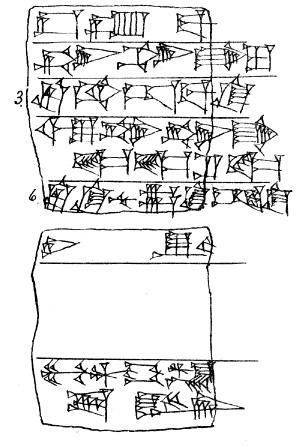Keywords
tablet, basket, tag, writing orientation
This material is based upon work supported by the National Science Foundation under Grant No. 0000629.
§1. Modern scholars read even the earliest cuneiform texts in lines from left to right although the archaic sign forms, which are still quite pictographic, are clearly lying on their sides if not read in columns from top to bottom and right to left like modern Chinese. The question of when the 90° change in the direction of the script took place has long been debated.
§2. Picchioni summarized the arguments for a very early date, just after the Fara Period, for the shift as follows: The “rotation theory” first propounded by F. Delitzsch which holds that vertical writing was used for hard materials while at the same time horizontal writing was used on clay has been supported by A. Deimel and A. Falkenstein. Deimel contended that it was easier to write horizontally than vertically given the type of stylus used and the way he imagined it was held, while Falkenstein suggested that the tablets themselves were rotated by the scribes because when held in the hand they were already at a 45° angle from vertical making a full 90° shift less noticeable.[1]
§3. Against the arguments for an early shift in the direction of writing, Picchioni has pointed out that until the Kassite Period most of the inscribed objects whose orientation can be established, such as vases, stelae, and statues, have writing that runs in columns from top to bottom rather than in lines from left to right.[2] There are only a few counter examples of horizontal writing before the Kassite period.[3] Additional evidence not cited by Picchioni for the direction of writing changing only during or after the Kassite Period is available in the form of pisan dub-ba.
§4. Etiquettes, also known as tags or pisan dub-ba, may indicate the direction of writing for any given period. Two connected holes on one side of many of these clay tags indicate where a string was threaded by which the inscribed tag could be attached to a container of tablets or goods. Very clear examples of such tags dated to the Ur III Period (2100-2000 B.C.) can be found in the collection of the Institut Catholique de Paris: ICP nos. 1, 2, 446, and 447 (full images of the entire collection are now available on-line at http://cdli.ucla.edu/links/icp_en.html). The holes are found on the left edge if the pisan dub-ba is oriented with the writing running from left to right, but at the top edge if the tablet is oriented with the writing running from top to bottom beginning at the right side.
§5. Published drawings of tablets very frequently do not indicate that there are holes (see figure 1). This is a strong argument for the importance of having good photographic images of the texts available.
fig. 1: TUT 164-03.
§6. Holes on the left edge of tags oriented in lines rather than columns are also well-known from the Old Babylonia Period. Goetze noted this for a group of 47 tags dated to the reign of the Early Old Babylonian Period king of Larsa, Sīn-iddinam (1849-1843 B.C.):
All these texts, some of them large as tags go, show the string holes characteristic for their class. The holes are invariably located in what we call the left upper and the left lower corners. When these tags were suspended from the string which once passed through the channel that connects the holes the script formed columns, not lines. This is the same arrangement which we find, e.g., on the stela of Hammurapi and also with seal cylinders of the Old Babylonian period. We, then, have here another indication of the fact that in Old Babylonian times the change in the direction of the script which made lines out of the earlier columns had not yet taken place.[4]
§7. The reason for the change in the direction of the script may have been the innovative nature of Kassite society, as Picchioni suggests.[5] Another possibility is that the wide-ranging nature of the change owes more to the international climate of the period in which Akkadian, using the cuneiform writing system, was the lingua franca from Egypt to Ugarit. The alphabetic scripts of Ugarit and the Levant were written in lines rather than columns, and Egyptian cursive writing was also always oriented horizontally.[6] This suggestion, however, is a subject for further research.
Notes
|
1 S. A. Picchioni, “The Direction of Cuneiform Writing: Theory and Evidence,” Studi Orientali e Linguistici 2 (1984-5) 11-26; cf. further his “Die Keilschriftrichtung und ihre archäologischen Implikationen,” Sumer 42 (1986) 48-54, and “La direzione della scrittura cuneiforme e gli archivi di Tell Mardikh - Ebla,” OrNS 49 (1980) 225-251. 2 Picchioni, SOL 2, 19. 3 J. Bauer, R. K. Englund, and M. Krebernik, Mesopotamien: Späturuk-Zeit und Früdynastische Zeit (=OBO 160/1; Freiburg, Switzerland: Universitätsverlag, 1998) 18 n. 1. 4 A. Goetze, “Sin-Iddinam of Larsa: New Tablets from His Reign,” JCS 4 (1950) 87. 5 Picchioni, SOL 2, 21. 6 A. Loprieno, “Ancient Egyptian and Other Afroasiatic Languages,” in J. M. Sasson, ed., Civilizations of the Ancient Near East 4 (New York: Charles Scribner, 1995) 2139. |
Version: 24 February 2003



